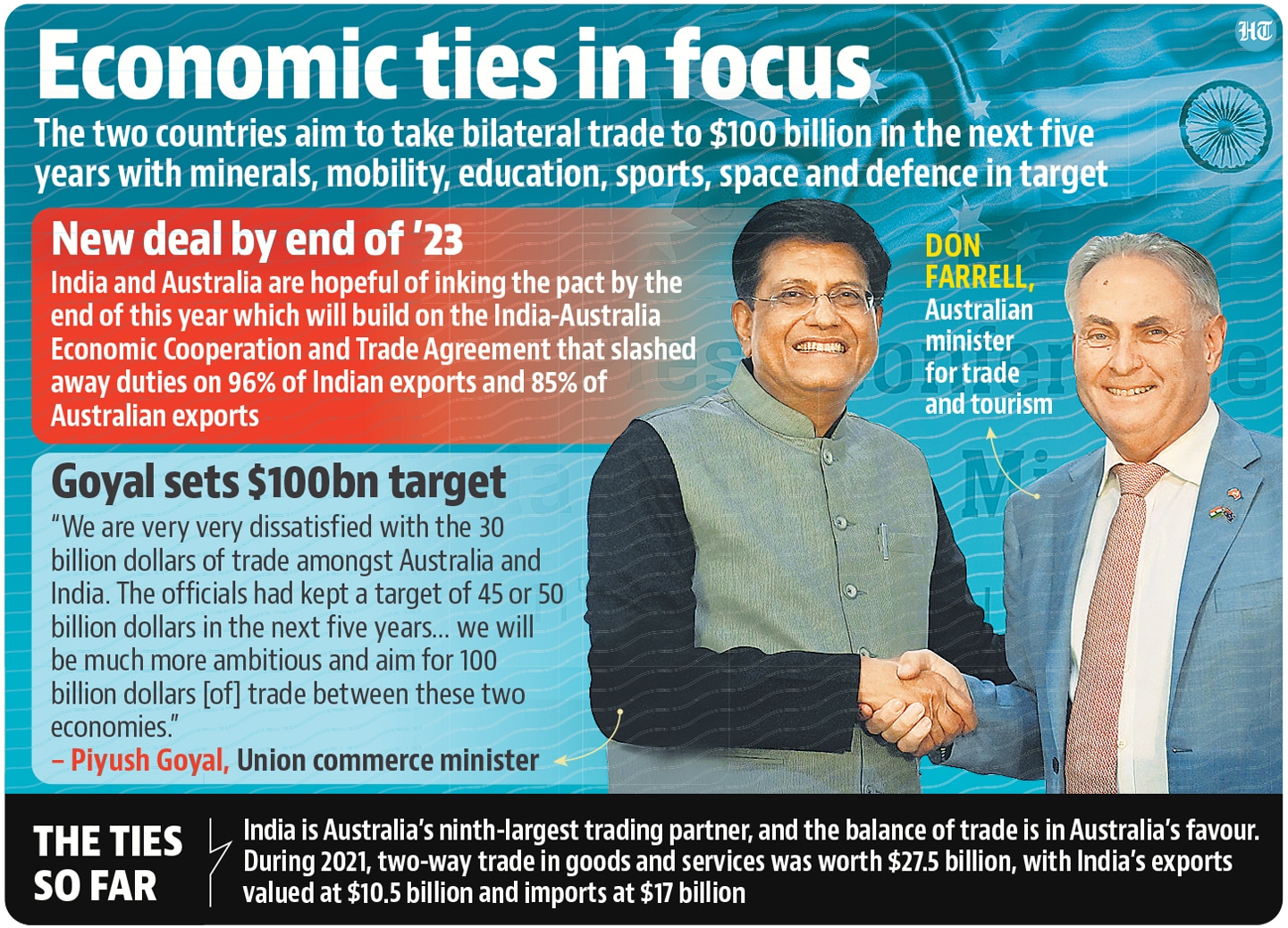India and Australia aim to take their bilateral trade to $100 billion in the next five years through a deal that will target new areas such as critical minerals, mobility, education, sports, space and defence being opened up to each other, the trade ministers of the two countries said on Saturday, hopeful of inking the pact by the end of 2023.
The deal will build on the free trade agreement, known as India-Australia Economic Cooperation and Trade Agreement (ECTA), that came into effect between the two countries last year, slashing away duties on 96% of Indian exports and 85% of Australian exports.
“We are very very dissatisfied with the 30 billion dollars of trade amongst Australia and India. The officials had kept a target of 45 or 50 billion dollars in the next five years. Both, minister [Don] Farrell and I have expressed our unhappiness to the trade negotiators… and we do hope, we will be much more ambitious and aim for 100 billion dollars [of] trade between these two economies,” India’s commerce minister Piyush Goyal said, standing alongside his Australian counterpart Farrell.
The meeting was part of the India-Australia 18th Joint Ministerial Commission meeting, which was held in New Delhi after the first round of negotiations for a comprehensive trade deal was completed. The ministers confirmed that the two governments have started negotiating a Comprehensive Economic Cooperation Agreement (CECA). According to negotiators, the second meeting for CECA is expected next month in Australia.
“This year we want to go in further than we did last year,” said Farrell, adding that new cooperation areas such as critical minerals, digital sector, space technology “can get to that target of 100 billion dollars that you [Goyal] have mentioned”.
On Friday, Farrell also met finance minister Nirmala Sitharaman to discuss opportunities for deepening India-Australia economic cooperation and the India-Australia Bilateral Investment Treaty (BIT).
Goyal said the trade in critical minerals, such as the ones used in manufacturing batteries for electrical vehicles (EVs), will help in reducing carbon emissions. “India is short of critical minerals. Australia has a large reserve of critical minerals…,” he said.
“Going forward, we would need those minerals for our EVs… It was also discussed at the prime ministers’ level,” he said. The Saturday meeting followed a summit between Prime Ministers of the two countries — Narendra Modi and Anthony Albanese — on Friday.
One of the negotiators, who did not wish to be named, said Australia not only has critical minerals in abundance but also has excellent mining technology that India could leverage. Union coal minister Pralhad Joshi and Australian minister for resources Madeleine King on Friday held talks on this matter.
“India and Australia have reached a major milestone in working towards investment in critical minerals projects to develop supply chains between the two countries,” a statement issued by the ministry of mines on Saturday said.
“Investments under the partnership will seek to build new supply chains underpinned by critical minerals processed in Australia, that will help India’s plans to lower emissions from its electricity network and become a global manufacturing hub, including for electric vehicles,” it said. Australia produces almost half of the world’s lithium, a key element in rechargeable batteries, and is the second-largest producer of cobalt, and the fourth-largest of rare earth metals in general.
Speaking about trade complementarity between India and Australia, Goyal said the two partners can contribute immensely in reducing carbon emissions. He referred to Prime Minister Narendra Modi’s vision “one earth, one sun and one grid”.
The minister said this is a work in progress as India is in talks with partners such as the United Arab Emirates (UAE) and Saudi Arabia to its west and Singapore to its east. “We would like to have a dialogue with Australia so that we can expand our grid connectivity… so that when sun rises in Australia, they can share their energy with us and in different hours when we have surplus energy, we can share it with Australia meeting each other’s peak load,” he said.
After the success of ECTA, the two partners are keen on moving to CECA, the official mentioned above said. Although ECTA was signed on April 2, 2022, the two countries ratified it from their respective legislatures and completed all formalities on November 29, 2022 by exchanging the documents. As per the agreement, the deal came in force a month after the exchange of documents on December 29, 2022.
India is Australia’s ninth-largest trading partner, and the balance of trade is in Australia’s favour. During 2021, two-way trade in goods and services was worth $27.5 billion, with India’s exports valued at $10.5 billion and imports at $17 billion.
Source- Hindustan Times.




